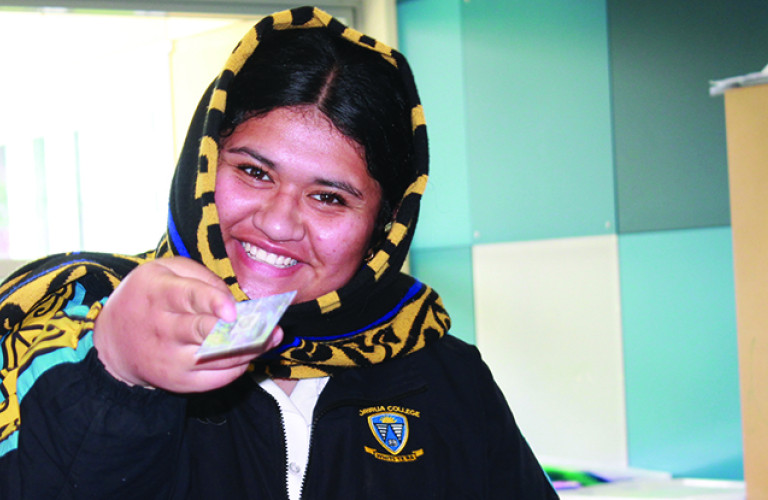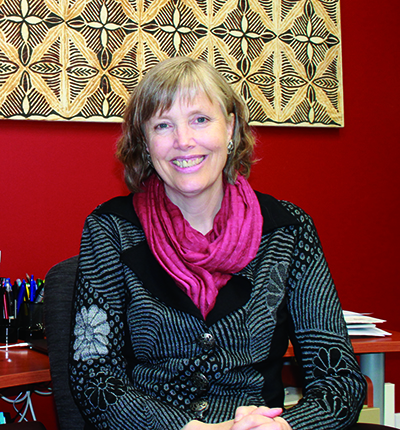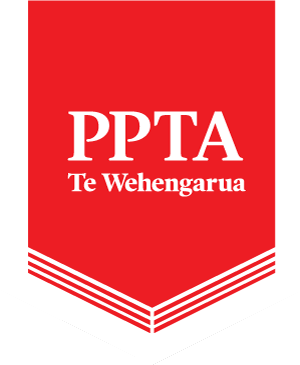Leadership with a Pasifika lens
PPTA News talks with Porirua College principal Ragne Maxwell, one of the pilot participants of the Tautai O Le Moana project for leaders of Pasifika students.


Ragne Maxwell
Porirua College principal Ragne Maxwell has always wanted to work in a school with a strong Pasifika population.
“It is such a strong part of the richness of New Zealand,” she said.
When the principalship for Porirua College came up, Ragne jumped at the chance. “This was my dream school to work at. I wanted to be in the Porirua community, and this was my first-choice school,” she said.
“We have some of the nicest, most respectful, warmest, most open and affectionate kids in New Zealand. I have been teaching for 30 years in school in New Zealand, Britain and France, and none has matched the warmth and whanau feeling,” she said.
“It was really hard during Covid because they had to stop hugging. The kids hug you, the parents hug you, people hug you all the time. We had to stop that because I could see us becoming a huge vector for Covid,” she said.
Out of her comfort zone
Porirua College is Ragne’s first principalship and in the four years she has been at the helm she has already made a lot of changes, both within the school and within herself.
Coming from the position of deputy principal at Kapiti College, a school made up of mostly Pakeha and Māori, Ragne felt she did not have the background with Pasifika students.
When Ragne heard of the Tautai O Le Moana - Strengthening the capability of Principals to improve outcomes for Pasifika Learners pilot, she was a bit nervous about signing up.
“I had done courses on ākonga Māori, but I thought, could I take that on with Pasifika? They are not one homogenous group. We have Cook Island Māori students, Tokelauan, Tuvaluan, Samoan, Fijian. How do I do this?”
She heard a number of principals in her Kāhui Ako Community of Learning were going to do it however, and that’s what drove her to join.
“If they were going to do it then, as a pakeha principal of a largely Pasifika school, I should. The group had a shared interest in what it takes to be leaders in Māori and Pasifika learning, and the majority of them were Pasifika and Māori. I needed to be a part of that,” she said.
Seeing through a Pasifika lens
Participants would meet individually with mentors – for Ragne this was Wellington Facilitator Sose Annandale, principal of Porirua’s Russell School, and national coordinator Auckland’s Target Road School principal Helen Varney – and then meet as a whole group.
“During the group meetings we would share challenges and questions, ideas and what we were actually working on in schools. We talked through shared experiences, sharing stories and unpacking what it is to have a Pasifika lens. It was a very different way of learning from lectures. It brought a Pasifika lens to learning,” she said.
“One of my challenges was leading Pasifika staff and understanding what was appropriate in terms of things like bereavement leave – for example to organise a pastor’s funeral. It was a touchstone for what was appropriate. You could take an issue you had and have a Pasifika lens on it. It was really helpful for me,” she said.
Go in with an open mind and heart
The Tautai O Le Moana project is now being extended (see opposite) and Ragne urges leaders to step out of their comfort zone and take part.
“We are all learning. Go in with an open mind and heart and know that you won’t be judged for your lack of knowledge. They are there to share with you.
“We have 60% Pasifika so the need to know for me was really obvious, but there are other schools out there with a significant Pasifika population. We have got to step up to the challenge that this opportunity puts in front of us. It would be great to see more Pakeha principals coming into the course. It is learning from people who are leaders in Pasifika schools in a way I can’t be, and I can take that and bring it to my school.
Making the curriculum relevant for Pasifika students
Before Ragne took part in the Tautai O Le Moana project she was already well on the way to changing things at Porirua College.
With a background in curriculum change, that was one of the first things she looked into.
“I found that parts of the New Zealand Curriculum didn’t work very well for our students. It’s a Western curriculum, very focussed on individual success and working as individuals. Group work and assessments are not particularly highly valued, yet group work is more culturally relevant to Pasifika students. We changed our approach to the curriculum to make it more group based and relevant to Pasifika kids,” she said.
Whare learning
PPTA News was given first-hand experience of the school’s educational vision of VAI (Voice, Action and Identity) during a tour of the school.
“Our students grow their voice to change the way things are and know that learners make a difference based on our multicultural community’s strength,” she said.
Their curriculum covers traditional subjects and also offers students the opportunity to learn in new areas, related to their passions. The classrooms are clustered around four learning houses – Kenepuru, Rangituhi Tangare and Whitireia – and students stay in one house for their whole time at the college.
“It’s like a whanau in a whare. The juniors do all their core subject learning in the whare and the seniors move about the school, but the whare is their home base,” she said.
The senior students are responsible for bringing the younger students into the school. “We are creating a curriculum where the older students are helping the younger ones know what they need for NCEA and also how to grow in their cultural learning.
Ko te Hapori
All students have a Ko te Hapori course for one fifth of their timetable. These courses are across year levels, to develop tuakana/teina (the relationship between an older and a younger person) learning.
“It involves the whole school, across year levels. We are large, connected, and team-taught. Exploring language and culture together.”
The courses provide opportunities for students to learn about, and within, their cultures, experience learning outside of the classroom and give back to their communities.
Students and whanau contributed to the development of the courses, which cover everything from carving and computer programming to designing and building electric bikes.
Year 12 and 13 students have a ‘Life after school’ option, which organises them into a flatting environment and has them deal with issues such as income and bills. “They experience what it’s like to put the practical puzzle together,” Ragne said.
They are us
The college offers Te reo, Samoan and Māori performing arts as subjects and has an ESOL class for students from Syria, the Pacific and elsewhere who need extra support in learning English.
PPTA News also visited the school’s Who Wants to be a Millionaire? class, where students learn about running their own businesses. There we met They Are Us – a Syrian-Pasifika fusion jewellery company.
Inspired by the support following the March 15 mosque attacks in Christchurch the group produces both paua jewellery and wooden bracelets carved with Arabic.
“We make jewellery inspired by our cultures – Muslim and Pacific Islands, CEO Vaveao Schuster said.
“Everything is handmade and we buy the materials with the money we earn.”
You can find They Are Us on Instagram as @Theyareus.nine
For more detail on Tautai O Le Moana, read our interview with national coordinator Helen Varney:
Last modified on Wednesday, 17 May 2023 09:11
